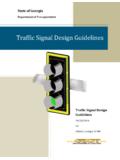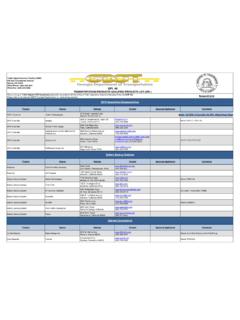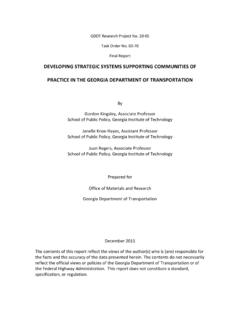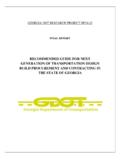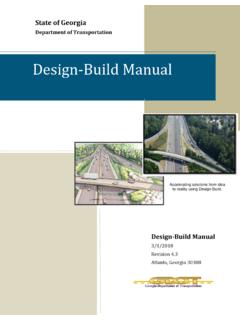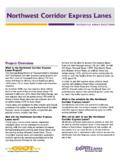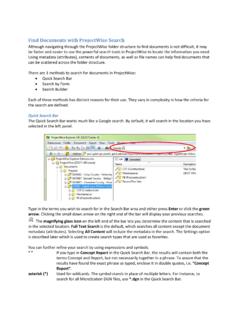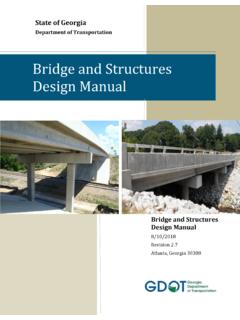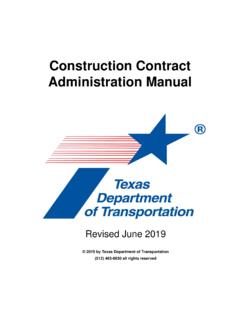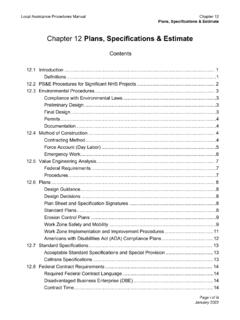Transcription of Section 150--Traffic Control - Georgia
1 Page 1 Section 150 traffic Control General Description This Section describes: Installation and maintenance of traffic Control devices during construction Projects let to Contract by the Georgia Department of Transportation. Guidelines and procedures for reducing the speed limit in areas where workers are present, or where roadway or roadside conditions create a potential hazard from construction or maintenance activities. Temporary speed limit reductions in work zones must comply with Georgia Law (Code Section 40-6-188). Definitions The traffic Control plan is defined in Special Provision Section 150, and is supplemented by the Plans, the Specifications, the current edition of the Manual on Uniform traffic Control Devices (MUTCD), and any applicable Supplemental Specifications. traffic Control devices referred to in this Section are devices specified in the Contract and the MUTCD and are used by a Contractor to regulate, warn, or guide traffic through a Project under construction.
2 Related References A. Standard Specifications Section 104 Scope of work Section 107 Legal Regulations and Responsibility to the Public Section 108 Prosecution and Progress Section 150 traffic Control Section 632 Portable Changeable Message Signs B. Referenced Documents Manual on Uniform traffic Control Devices (MUTCD) Official Code of Georgia Annotated (OCGA): 40-6-188 Georgia Utilities Coordinating Committee (GUCC) Manual (also known as Manual on traffic Control Procedures for Utilities) Submittals A. Contractor Responsibilities Prior to construction, the Contractor shall submit a detailed staging and traffic Control plans for performing specific areas of the work including but not limited to all traffic shifts, detours, bridge widening, paces, lane closures or other activities that disrupt traffic flow. A Plan of operation and sequence of work , along with Section 150 traffic Control Page 2 any appropriate Provisions for traffic Control , shall be submitted to the Project Engineer for prior approval before beginning any work .
3 NOTE: The Contractor s primary responsibility is for safe passage of pedestrian and vehicular traffic through the work zone with minimal confusion and traffic flow disruption. At a minimum of 14 days before a major traffic shift on the Project, the Contractor shall submit additional traffic Control details, as outlined in the Special Provisions, to the Project Engineer. B. Project Engineer Responsibilities 1. Before construction, inspect the initial installation of the traffic Control devices. 2. Periodic inspections of the conditions of the devices and their effectiveness in the work zone. a. If problems are encountered, the District traffic Operations Office can assist with solutions to improve traffic Control . b. Document inspection in Contract Diary. 3. Daytime and Nighttime inspections should be made as conditions warrant. 4. Observe traffic movements while operating under the traffic Control devices. 5. Report lane closures and openings as follows: a.
4 Report Projects that routinely require a lane closure only once, unless the operation changes, such as stopping work for a long period of time or switching lanes. b. Report intermittent lane closures each time they are closed to keep the Office of Construction aware of the actual Project conditions. c. Follow the procedures outlined in Section C, traffic Interruption Report. 6. Notify the Area Engineer when unusual situations arise that requires a lane closure. The Area Engineer should then notify the District Construction Office and the State Construction Engineer. Send a fax to the District Office and to the State Construction Office. 7. The Contractor shall not begin a major traffic shift until the Project Engineer has approved the following: a. A set of traffic Control details b. Any proposed lane shifts, closures, or traffic pacing c. The removal, storage, and protection of any existing street lights, signs, or sign supports 8. The Project Engineer will periodically prepare the Form 1, traffic Control Inspection and submit it to the Contractor.
5 The Project Engineer will review the form to ensure the Contractor has corrected all deficiencies in a timely manner. The Project Engineer will file all completed traffic Control forms at the Project Office. For further information, refer to Subsection , Public Convenience and Safety in the Specifications. Section 150 traffic Control Page 3 C. traffic Interruption Reports Report all detours, road or lane closures, openings to traffic and other traffic interruptions using the traffic Interruption Report. The Office of Construction and the Communications Office use this form to stay informed of construction activities affecting traffic . Note: The form is an electronic form. The fill in version of the form is located on sv35, click on Forms97, click on Fill-ins and look for the traffic Interruption form. Once the form is completely filled out, send the form by e-mail (or fax) to the following distribution lists: All traffic interruptions in Clayton, Cobb, Dekalb, Douglas, Fulton, Gwinnett, and Rockdale Counties shall be reported to: Assistant State Construction Engineer Construction Liaison Engineer District Construction Engineer District Maintenance Engineer Area Engineer District Media Coordinator TMC via e-mail (TMC-TrafficInterruptionReports) Office of Communications via e-mail (Communications Office-TIR) When the interruption ( , lane closure, detour, etc.)
6 Is actually in place notify TMC by Southern Linc (TMC SL # 28291) or 1-888-424-4929, or 404-624-2653 or fax 404-635-8004. When the interruption is complete and all lanes are open to traffic , notify TMC by Southern Linc or phone. All traffic interruptions on the Interstate System Statewide shall be reported as follows: Assistant State Construction Engineer Construction Liaison Engineer District Construction Engineer District Maintenance Engineer Area Engineer District Media Coordinator TMC via e-mail (TMC-TrafficInterruptionReports) Office of Communications via e-mail (Communications Office-TIR) Section 150 traffic Control Page 4 When the interruption ( , lane closure, detour, etc.) is actually in place notify TMC by Southern Linc (TMC SL # 28291) or 1-888-424-4929, or 404-624-2653 or fax 404-635-8004. When the interruption is complete and all lanes are open to traffic , notify TMC by Southern Linc or phone. All other traffic interruptions shall be reported to: District Construction Engineer District Maintenance Engineer Area Engineer District Media Coordinator These traffic interruptions DO NOT require the notification of the Assistant State Construction Engineer, TMC, or Communications; unless it is determined the interruption would significantly disrupt traffic .
7 When filling out the form: 1. TIME Section : Put the hour and AM or PM, such as 7AM or 8PM. Do not add minutes to the TIME Section . 2. LOCATION Section : Note the direction WB, NB, etc. Give specific names of the roads, mileposts or exit numbers. Do not give station numbers. Be Specific. Give as much specific information as needed to describe the location, and the number of lanes closed. 3. HOW WILL traffic BE AFFECTED Section : List the closure as single, double, pacing traffic , opening new lane, temporary ramp closure, shifting lanes, etc. 4. PURPOSE Section : Describe the work taking place, milling and resurfacing, striping, setting beams, utility work , etc. 5. CONTACT Section : The name of the Contractors representative who will be ON SITE during the traffic interruption. Also, the name of DOT representative who will be ON SITE during the traffic interruption. All information on the bottom of the form must be filled in. If you have a Southern Linc add your number under ADDITIONAL INFORMATION If the report submitted is for several days, note DAILY on the form.
8 NOTE: If conditions during construction or traffic interruption reduce the horizontal clearance to less than 16 feet and/or reduce the vertical clearance to less than 15 feet, the reduced clearances shall be clearly noted under Additional Information . If an oversize load detour is initiated, provide this information on the form. Send a copy of the form to Permits via e-mail, (OS/OW- Section 150 traffic Control Page 5 TrafficInterruptionReports), or fax to 404-635-8164(OW) and 404-635-8501 (OS). This applies to all interruptions regardless of county or route. The form should contain only one activity per report, unless multiple activities will occur simultaneously in the same general location and during the same time frame. The following schedule should be followed: 1. Notice of openings should be given two (2) weeks in advance of implementing the change. 2. Notice of detours should be given one (1) week prior to implementing. 3. Lane closures and other traffic interruptions should be reported a week in advance and at no time less than three (3) days prior to implementing.
9 Earlier notification is desirable. NOTE: If a computer is non accessible a hard copy of the traffic Interruption Report, can be filled in by hand and faxed per current procedures. Materials A. Delivery, Storage, and Handling Store and protect removed streetlights, signs, or sign supports as required by the Contract provisions or as directed by the Engineer. Construction Requirements A. Personnel The Contractor shall designate a qualified Worksite traffic Control Supervisor (WTCS) who shall be responsible for administering the traffic Control Plan according to the Contract. 1. Worksite traffic Control Supervisor (WTCS): Be responsible for selecting, installing and maintaining all traffic Control devices in accordance with the Plans, Specifications, Special Provisions and the MUTCD. Have appropriate training in safe traffic Control practices in accordance with Part VI of the MUTCD. Ensure that all traffic Control devices are effective and comply with the traffic Control Plan.
10 Exercise full authority to act on behalf of the Contractor in administering the traffic Control Plan. Be available on a 24-hour basis and be able to respond effectively to an emergency within 45 minutes of notification. Supervise the installation of the traffic Control devices before construction. Review any modifications to the traffic Control Plan before submitting them to the Project Engineer. Section 150 traffic Control Page 6 Inspect the traffic Control devices on a regular basis to ensure that they meet the requirements of the traffic Control Plan. Monitor the work to ensure that all potential hazards are kept clear of the traffic and that dust, mud, and debris do not interfere with normal traffic operations or adjacent property. Ensure that the WTCS is certified when working on limited access highways. NOTE: No work shall begin on any phase of the Project unless the appropriate traffic Control devices have been placed according to the Contract requirements.

